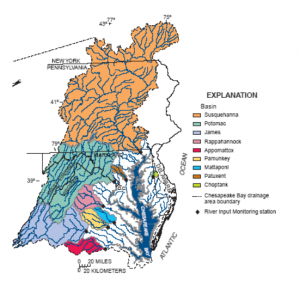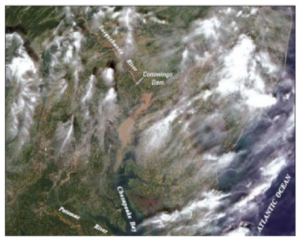The Chesapeake Bay is a great example of how many things in nature are interrelated. The sedimentation issues seen through the bay are a great specific example. The sediment that floods the bay and effects both water quality and biotic life does not come immediately from the bay, or even just from the surrounding shoreline. The watershed drains around 64,000 square miles and sediment is transported through the drainage basins and river channels to the bay itself. Loose sediment from construction, timber harvesting, and farming makes its way, through the six states that make up the watershed, all the down to the bay.

Data has pointed to land use as being a highly important factor in determining sediment yield (the amount of sediment that is transported from an area into the bay, annually). Research shows that river basins whose land use have a high percentage of agricultural lands have the highest annual sediment yields, opposed to river basins with larger percentages of forests land that have conversely, the lowest sediment yields. Looking at which areas sediment comes from can help in future mitigating sediment runoff as it will give managers a focused area to regulate.
Development and logging are not the only factors that have greatly increased sediment yields since the 1800s. Climate change also plays a role. Often sediment that reaches the bay is picked up by streams and rivers when their flow is higher than normal. When rivers are running at bank-full flow instead of base-flow they are ab le to pick up loose sediment that they wouldn’t normally reach. This is a common occurrence during rain events. Large storms have become much more prevalent in the past 50 years, corresponding with the increase in sediment yield. In the image on the right you can see the extent of murky water in the Chesapeake Bay that has been stirred up and suspended during Hurricane Ivan in 2004.
le to pick up loose sediment that they wouldn’t normally reach. This is a common occurrence during rain events. Large storms have become much more prevalent in the past 50 years, corresponding with the increase in sediment yield. In the image on the right you can see the extent of murky water in the Chesapeake Bay that has been stirred up and suspended during Hurricane Ivan in 2004.
More development, more farming, more deforestation, and more storms all serve to increase sediment deposition into the Chesapeake Bay. These are the areas we need to look to regulate if we wish to improve water quality and biotic living conditions in the bay itself.
Informative Links:
USGS’ summary of sediment processes in the bay
USGS’ assessment of the impact of sediment in the bay
Leave a Reply